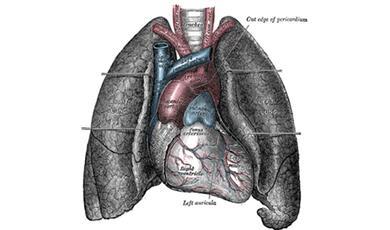The Future of Health Globally
Share
- Details
- Transcript
- Audio
- Downloads
- Extra Reading
This lecture looks at the very optimistic picture of trends in health around the world. Childhood deaths and the diseases of young adults are falling rapidly. Scientific advances are transforming the major chronic diseases and cancer. In low, middle and high income countries, health is improving through to old age. There are some major exceptions, such as dementia, but the extraordinary advances in health over the last decades is set to continue.
Download Transcript
The Future of Health Globally
Professor Chris Whitty
18th May 2022
Global health is improving at a remarkable pace due to a combination of medical science and development. This lecture pulls together threads from many previous lectures to consider what is likely to happen to health globally over the next decades. A previous lecture considered the future of health in the NHS and high-income countries more widely and this takes a wider view, although inevitably a relatively broad-brush one. These notes are to indicate the areas covered in the lecture and are not a transcript.
The biggest change that has happened, and is continuing to happen, is reductions in child mortality. Child mortality is dropping fast everywhere, and this will have its biggest impact in areas where child mortality is currently high, which are generally lower income countries. This is leading to a changing global population structure. The lecture will consider children under five, older children and young people, adults in their first half century up to 50 years, adults in the next quarter century up to 75 years, and older adults. As with children, mortality rates in adults up to the mid-70s are steadily improving around the globe. There are some significant risks to this which this lecture will consider. The health of older adults is more complex and in some areas progress has been very slow. The picture is however optimistic overall.
Children Under 5 Years Old
The improvement in under five mortality around the world has been remarkable. It is not complete yet. There has been a 61% decline in mortality in this age band between 1990 and 2020 and this improvement will continue. The substantial drop in under five mortality started around 1900, although it had been drifting down before then, and has continued to date. In every part of the world not actively at war, child mortality has fallen. The biggest absolute drops have been in parts of Africa, Asia and Latin America but they have still not reached the extremely low rates of child mortality in high-income settings. They will approach these very low rates over the next decades.
The first big improvements were in sanitation and malnutrition. Clean water and sanitation significantly reduce the risk of fecal-oral diseases and subsequent avoidable deaths. Once it improves, the advantage seldom goes backwards except as a result of disasters such as earthquakes or wars. There is however still room for further improvement with over 2 billion people lacking access to safe drinking water. Sanitation can also improve. Where it does mortality will improve further. Undernutrition has steadily fallen since the 1970s but there is still a significant burden of this, and COVID-19 has had a negative impact on it. It is likely to be exacerbated by the current war in Ukraine. There are however likely to be further improvements in child mortality as sanitation, water and malnutrition improve.
Vaccines have had a remarkable impact on childhood diseases including respiratory and fecal oral diseases. Vaccines such as Hib have reduced meningitis, rotavirus vaccine has reduced diarrhea, and pneumococcal vaccine has reduced pneumonia. These improvements in vaccine preventable deaths are likely to extend over the coming decade.
Vector-borne infectious diseases have historically had a major role in child deaths of which the most important is malaria. Through a combination of insecticide treated bed nets and drugs, deaths have over halved since 2000. Insecticide and drug resistance and recently COVID-19 have led to some increases in the last two years after a steady period of decline and this will need to be reversed.
The combined effects of these improvements are that countries starting from very different points are converging on the same low rate of mortality for children under five.
Improvements in neonatal mortality (first four weeks) have been slower than for other childhood causes of mortality and are therefore increasing as a relative although not absolute cause of child deaths. Relatively straightforward interventions will lead to significant reductions in neonatal mortality, and this should be a priority. Overall, children under five still make up a very high proportion of deaths before the age of 60 years but this is dropping rapidly everywhere.
Children and Young People 5 Years and Over
The risks of children over 5 years and young people under 20 years dying are very low relative to all other ages, and this also is improving. The result is a shift towards death in old age because a reduction in child deaths under five does not lead to an increase later in childhood but rather much later in life.
Population Structure and Demography
Historically, there has been concern that whilst reducing child mortality is positive, it would lead to substantial over population. This was most clearly laid out by Thomas Malthus who postulated that populations inevitably increase until limited by resources. Whilst reasonable in theory, this is wrong on the data. Once there is low child mortality, widely available contraception, female education and reduced poverty, fertility rates have almost always declined. The current global fertility rate has now fallen to around 2.5 births per woman, slightly above the replacement level of 2.1 births per woman. In much of the high-income world including Europe, North America and East Asia, fertility rates have fallen below replacement levels and they are dropping rapidly in most other areas. At some point in the next few decades, overall global fertility rates will drop below replacement levels, and this will inevitably lead to a stabilisation, and eventually a sustained decline in total human population.
Health in Adults up to 50 Years Old
The period of young adulthood, which in medical terms encompasses the first half century up to 50 years, already constitutes a very low risk of dying in most parts the world. Some infections are particularly high risk in young adults, in particular those acquired sexually (which tend to occur early after sexual debut in early adulthood) including HIV and viral causes of cervical cancer and liver cancer. We now have treatments for HIV and vaccines against HPV and hepatitis B.
Turning to non-communicable diseases, most cancers are rare under 50 and treatment of these is improving. Although much cancer treatment is not yet accessible to people in less wealthy countries with health services which are highly resource constrained, economic development will lead to a gradual extension of global access to existing and new treatments. Cardiovascular deaths such as fatal heart disease or stroke are also rare before 50 years, and in high income settings declining.
Inevitably, some diseases which cause non-fatal but serious illness including diabetes driven by obesity, and in some places, asthma is increasing. Overall, however, the outlook for younger adults is good and getting better. Major risks in this age group include road traffic accidents, accidents at work, accidental poisonings, suicide and homicide. Road traffic accidents and accidents at work can be substantially reduced by state action. Regulations to improve safety at work, safety of vehicles and roads, testing of driving ability are examples which can lead to reductions. The result is that deaths on roads and from accidents at work are much lower in high-income countries and middle-income countries; this improvement is likely to expand as countries develop.
While the outlook for physical health in adults under 50 is already good and improving, this is the peak period for people to first develop significant mental health disorders. Many of these first appear in late adolescence or early adulthood. The remarkable improvements in physical health we have seen over the last few decades have not been as rapid in mental health. Improvements have occurred in both treatment and to a lesser degree prevention, but because its progress has been slower, the relative importance of mental health is increasing and likely to continue to.
The combined effects of all these are that globally life expectancy is improving all the time, even when there are setbacks in specific countries.
Health in Adults 50-75 Years
There is a large amount of overlap but, in broad terms, as they develop countries move from a situation where mortality is dominated by infectious diseases in younger people, to one where cardiovascular and then cancer deaths dominate, and finally to a situation where a high proportion of people have multiple conditions and degenerative diseases in older age. The UK is an example of a country which has gone through this transition. Almost all countries globally are however developing along this pathway.
Cardiovascular diseases, in particular heart disease, are very important in the age band 50-75. In high-income countries, the rate of deaths from these diseases in those under 75 has however been dropping very rapidly. In many middle-income countries, deaths from cardiovascular disease are static, or in some cases even rising slightly. We can be confident that these problems will reverse because the improvements in cardiovascular disease come from multiple steps, most of which are available to almost all countries. These include reductions in smoking and air pollution; relatively cheap drugs including statins and antihypertensives; clot busting drugs; cardiac stenting and cardiac surgery which require better resourced health services. Working against this improvement are rising rates of obesity and diabetes, and in some countries rising smoking rates.
The outlook for many cancers has substantially improved over the last decades. Mortality for most cancers is dropping and survival rates are still increasing. As countries develop, their ability to access the treatments which underlie the substantial improvement in cancer outcome will steadily expand and it is realistic to see rapid progress towards better outcomes from cancer mortality as a result. For a small number of cancers, of which the most important is lung cancer, there has been very little progress even in very well-resourced health systems. Depressingly, almost all cases of this common fatal disease were avoidable if the cigarette industry had not addicted people at a very young age for profit.
What is Not Going Well
Not everything is going the right way. In addition to rising smoking rates in some countries, obesity is increasing globally. As countries become wealthier, obesity rates have historically increased. This significantly increases the risks of multiple diseases including diabetes, heart disease and some cancers, which tend begin to become apparent in the 50-75b age band.
Backward pressure on progress which affects all ages is also seen in the spread of antimicrobial resistance and insecticide resistance which, without further action, could lead to us losing important tools which have led to some of the extraordinary gains we have seen so far. Climate change also provides a backward pressure on improvements in health through multiple routes, some direct such as heat stress, and some indirect such as having a negative impact on agriculture and economic development.
Even with these potential threats to health however, the outlook for improving mortality in those under 75 is good.
Health Over 75 Years
This is leading to a steady concentration of mortality in an age band over 75 (but under a hundred years). In these older citizens the outlook for individual conditions such as heart disease or cancer is improving and, since they are at greater risk than younger adults, the absolute impact of medical science on their health has been substantial. We also have treatments for many degenerative diseases of older age such as arthritis of the hip. These improvements will disseminate globally as countries become wealthier.
There are however diseases of old age which we do not have a good treatment for yet, such as the major dementias. Additionally, old-age individual chronic conditions accumulate. Medical science is designed around single diseases. As populations age, there will be a preponderance of older people with multiple conditions simultaneously. This will lead to increasing frailty and dependence. Whilst steady improvements in science and health in younger ages is occurring and will get better still, it is less clear how science will develop in these areas of multi-morbidity (although it will). How we support people in older age as they become frailer is as societal as much the medical question and the answer may vary by society.
Summary
The mortality of children under five is dropping very fast, although slower in the neonatal period, and the impact of this on population structures is remarkable and irreversible. The health of adults under 50, who already have a low risk of dying, is steadily improving everywhere. Health of those 50 to 75 is also improving globally but with some risks increasing including smoking and obesity. Longevity and health in older people over 75 years old is improving but there are slower improvements in reducing disability and frailty. While recognising the limits, we should recognise the triumphs of medical science and development which are likely to continue over the next decades.
© Professor Whitty 2022
This event was on Wed, 18 May 2022
Support Gresham
Gresham College has offered an outstanding education to the public free of charge for over 400 years. Today, Gresham plays an important role in fostering a love of learning and a greater understanding of ourselves and the world around us. Your donation will help to widen our reach and to broaden our audience, allowing more people to benefit from a high-quality education from some of the brightest minds.


 Login
Login







